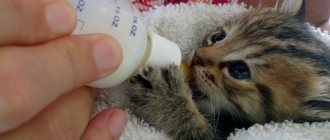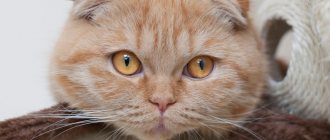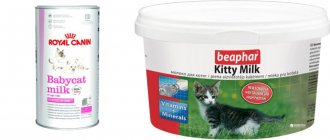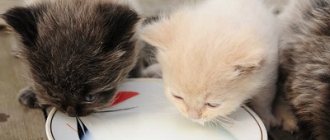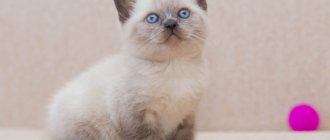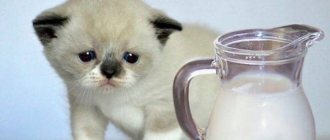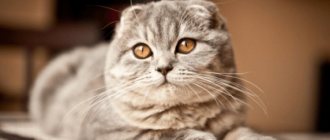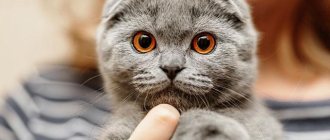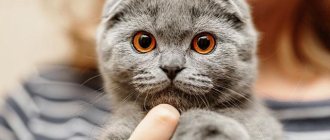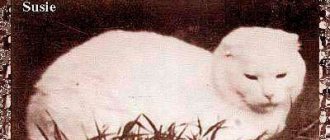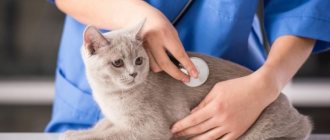Story
Officially, the fold-eared breed is about 60 years old, but why these animals have such an unusual ear shape still remains a mystery. However, there are a number of theories on this matter, for example, that cats lived for a long time in some very windy areas, and in order to protect their ears from blowing, Mother Nature decided to change their shape.
There are also hypotheses according to which long ears prevented cats from hunting because they stuck out above the low grass, as a result of which they mutated, but it is not clear why such a mutation is not observed in other breeds.
At the moment, the dominant point of view in scientific circles is that fold-eared cats appeared due to a random mutation, that is, according to nature’s plan, they should not have appeared, but something went wrong, and we got another breed.
But then the natural question is why this spontaneous mutation manifested itself in lop ears? Why didn't the paws, or, for example, the tail mutate? More information about the theories of the origin of the breed can be found in reference books on felinology.
Features of natural nutrition of Scottish kittens
Feeding a little Scot has its own characteristics. Every month, as your pet gets older, you need to add new foods to its diet. It is important to maintain the right combination of proteins, carbohydrates and fats. Proteins of animal origin must predominate to ensure normal development of the muscle corset.
Feeding a kitten from 1 to 2 months
The amount of food per day is up to 120 g. Raw lean meat is required; chicken or turkey are ideal. If a kitten grows up without mother's milk, the introduction of meat into the diet can begin at 3 weeks. It is ground using a meat grinder to obtain the consistency of minced meat.
From 1.5 months, meat can be cut into small pieces. Preference should be given to chicken, turkey and rabbit. It is not recommended to give beef, as it has wide fibers, and the kitten’s body cannot digest them normally. They also begin to introduce porridges boiled in a large amount of water to obtain a liquid consistency.
Diet at 2 and 3 months
The volume of food of an older kitten increases to 160-180 g per day. Meat is the basis of the diet, cut into cubes. The diet must include vegetables - they are boiled, chopped finely and mixed with meat. For Scots from 2 to 3 months, you can begin to accustom your kitten to commercial food, dry or wet.
Nutrition for a 3 and 4 month old baby
This age is characterized by the kitten’s active growth and muscle mass gain. In addition to cut-up meat and porridge with vegetables, the little Scotsman needs to be given store-bought vitamins that contain calcium.
If the Scotsman eats industrial feed, there is no need to give additional vitamins. But this only applies to those cases when the kitten consumes premium food and holistic products. Only these types of industrial feed can provide the animal with all the necessary mineral elements and vitamins that ensure normal development.
4-5 months
The volume of food gradually increases and is already 180-1240 g. The meat is cut into large pieces. The diet includes fish, but only low-fat varieties. You can give it only once a week, not more often. If fish is given to a cat once a month or less, and only as a treat, you can give preference to fattier varieties, for example, salmon. But it is permissible to pamper your baby with fatty fish extremely rarely and in very small pieces.
Diet from 5 to 9 months
Meals are provided up to 4 times; there should be no feeding at night. A Scot can already consume all permitted foods by this age. The basis is lean, raw meat and vegetables with cereals. It is recommended to gradually accustom the kitten to greenery. Giving him street grass is strictly prohibited.
If a cat shows interest in grass, it should be purchased at pet stores. It is sold in the form of grains, which are planted in the ground to germinate a healthy delicacy.
How to properly cook meat for Scottish cats
There is an opinion that giving raw meat to cats is strictly prohibited, because through it the pet can become infected with parasites. But there is also a theory that boiled meat is an unnatural product, because under natural conditions this product is consumed only in its raw form.
Raw meat can and should be given to the Scots. In boiled meat, after it has undergone heat treatment, all its beneficial properties disappear. Raw meat must be refrigerated for at least 3 days before giving it to your pet.
The low temperature in the freezer kills possible parasites, helminths and their eggs in the meat. However, if raw meat is present in the Scotsman’s diet, preventive helminthiasis must be carried out every 4 months.
What to feed
Today, veterinarians claim that you can feed cats only with ready-made food or prepared food yourself , and this is not without reason, since by now a lot of experience has been accumulated in animal nutrition.
At the same time, it is impossible to mix homemade food with ready-made food, since this is fraught with various distortions, for example, if you feed a cat with dry food and at the same time feed it with meat, it will develop an excess of protein, which manifests itself in the form of eye boogers.
But these are still “flowers”, it is much worse when the animal does not have enough vitamins, or, on the contrary, there are too many of them - in this state the animal will suffer very much.
Milk for adult cats
Dairy products for cats, just like milk for cats, are a great treat. Milk can be given to cats if individual tolerance is good and there are no allergic manifestations. But it should be noted that castrated cats are prone to obesity, and cow product contains 149 kcal.
Therefore, drinking plenty of this drink together with dry food or food from the table can lead to an increase in the weight of the animal, which will negatively affect the cat’s body as a whole.
Therefore, you need to feed your cat dairy products in moderate doses. For a cat, as a more active creature than a lazy cat, these calories are not so significant, so cats can drink milk in any volume.
Prepare food or shop
Preparing food for cats on your own is very difficult, as it requires precise adherence to the proportions of substances, so preparation takes a lot of time.
Usually those housewives who have a lot of free time and do not need to cook for the family feed “by hand”. It is especially dangerous to feed small kittens on your own, because their digestive system is not yet strong, and the body as a whole is weak, so they must receive all the substances, vitamins and microelements they need, which means that the cook requires deep knowledge in nutrition.
In this regard, ready-made feeds have a great advantage - they are completely balanced, they contain everything you need, and in the volume that is required.
Just don’t buy cheap ones - they have practically no meat, maximum skin, and in addition, there are many substances that have a negative effect on the animal’s body, but in our country they are used because it is profitable.
Important: European feeds, such as Shezir, do not contain harmful substances, since they are simply prohibited there. There is no need to listen to those who say that feed is made on the same equipment, and therefore they are supposedly the same. The equipment may be the same, but the raw materials that pass through it are very different.
Features of a natural diet
Not all natural products can be used for the daily menu of Scottish kittens. The main list of permitted products is as follows:
- Beef is used raw or boiled. If the owners chose the first option, it is recommended to pre-freeze the meat. Many worms die from subzero temperatures. Kittens can be given meat from the age of 3 months. The portion should be small: approximately 30 g per feeding.
- Chicken breast. It is best used boiled and crushed. The portion should also be small; you can feed it from 2 months.
- The liver causes diarrhea in small kittens, so it is included in the diet occasionally (no more than once a week) and in small portions of 10-15 g, always boiled.
- Fish should be present in the diet, but not as a daily three meals a day. Use low-fat fish (for example, hake, blue whiting, carp, perch). Before feeding, the fish is boiled, the bones are removed, and you can grind it in a meat grinder until it becomes minced meat. Excess fish in the diet creates problems with kidney function.
- Egg yolk is introduced into the diet occasionally (1-2 times a week).
- Milk often causes stomach upset in adult cats, so it is better to include fermented milk dishes in the diet - kefir, low-fat cottage cheese, sour cream, fermented baked milk. Usually cats love this treat. You can pour a little kefir into a saucer at night, even if the kitten gets hungry, this feeding will allow it to last until the morning.
- Milk porridges are used to feed small kittens (up to 6 months). It could be semolina porridge or oatmeal, chopped buckwheat. Older pets should eat a side dish with butter or vegetable oil, but without milk, to avoid indigestion.
- Cereals (rice, buckwheat, egg, semolina, oatmeal) can be used together with a meat or fish dish. Cats are still predators, so the proportions must be observed: meat or fish - 2/3, side dish - 1/3. The side dish is added to the portion several times a week.
- Vegetables and herbs should also be present on the four-legged pet’s menu. This could be special grass, carrots, cucumbers, cauliflower. Vegetables are boiled, pureed and added to minced meat. Some cats express a desire to eat fresh vegetables and fruits (for example, cucumbers, melons, pumpkin). There is no need to interfere; perhaps the kitten has a lack of some vitamins in the body.
Fermented milk products should be used separately from the main menu. There is no need to add kefir to porridge or meat. Cottage cheese can be mixed with sour cream and served as an afternoon snack; kefir or fermented baked milk can be left overnight.
Need for vitamins
The menu for Scottish kittens should additionally include vitamins A and D. Veterinary pharmacies purchase special multivitamins for Scottish kittens or regular fish oil. This will saturate your small pet’s body with the necessary vitamins and microelements.
Drinking regime
A bowl of water should be in the baby’s constant access. This way he gets used to drinking the amount of water necessary for normal functioning. Scottish kittens are so spoiled that they will have to change their water twice a day. Any speck becomes a nuisance, and the baby looks for another place to quench his thirst.
Many pets get used to drinking only from the tap. Therefore, it is advisable to install a filter on the water supply system in your house or apartment.
List of harmful foods
There are foods that can harm the health of Scottish kittens:
- Pork is the main source of helminthiasis, so it is better to avoid feeding pork. There are two more compelling arguments why pork is harmful to cats. This is very fatty meat. In addition, this is the source of Aujeszky's disease. Pigs are considered the hosts of the pseudorabies virus. The virus is not dangerous for people, so the meat of slaughtered animals is not examined for virus carriage. A cat can become infected with false rabies by eating pork. The virus is deadly for kittens. Animals older than 1 year can cope with the disease, but this is done with great difficulty and not without the help of veterinarians. Only individuals with strong immunity survive.
- It is not recommended to include fats in the diet of kittens.
- Smoked and salty foods are extremely dangerous for children.
- You should not pepper, salt, or add various seasonings and spices to cats’ dishes; this can spoil the cat’s sense of smell and cause irreparable harm to health.
- Sweets and starchy foods are harmful to a growing body. Buns, cakes, ice cream, sweet drinks, and candies can disrupt metabolic processes in the body and cause obesity. Cats do not taste sugar, so they are able to eat a huge amount of treats. A regular excess of sugar in the diet causes disruptions in the functioning of the pancreas, which provokes the development of diabetes. Diabetes causes vision problems. The disease is accompanied by a sharp deterioration of vision or blindness. Chocolate contains theobromine, an alkaloid that causes a rise in blood pressure, excitement and an elevated pulse. A piece of sweet treat can turn into such a nuisance for your baby as severe theobromine poisoning. In the future, such experiments with nutrition can lead to cardiovascular pathologies. Urolithiasis occurs not only when a pet is addicted to fish. Sweets also cause kidney overload, which leads to the development of kidney diseases. Pregnant cats eating sweet buns can give birth to kittens with deformities. A passion for sweets leads to intrauterine fetal death and stillbirth. Dishes with sugar are dangerous for the development of an allergic reaction in kittens.
- Chicken bones can cause gastrointestinal injuries. When chewed, tubular bones form sharp edges that can pierce the stomach and cause inflammation, perforation, and peritonitis.
Nutrition by age
At first, the kitten is fed only by the cat with its own milk, but if it is not available, it is necessary to give a substitute. At two months, switch from milk to dry food.
Up to a year, buy it marked “Junior”, and after that you can give regular dry food, occasionally pampering your pet with wet food or pate. Why occasionally, because if you give the delicacy often, the animal will become spoiled and refuse to eat “simple” food, which is much cheaper.
Important: follow the brand, that is, buy food from the same series. For example, if you give Perfect Fit dry food, you should not buy Proplan pate, since although the food consists of the same substances, they use different flavoring additives, which can also affect digestion.
Alternating cheap and expensive food has a particularly bad effect on a cat’s body, since there is a contrast not only in flavor additives, but also in nutrients.
General feeding rules
Typically, kittens are purchased at the age of 3-4 months, when their body is able to do without mother’s milk and is partially accustomed to new “adult” food. To correctly create a menu and feed your baby, you need to take into account a number of factors:
- The baby's stomach is very small, and activity is increased, so feeding should be frequent and portions small. For example, at the age of 3 months, a kitten is fed 5-6 times a day, and an older 4-month-old baby needs to be fed 4 times a day;
- a pet that does not have enough food will develop poorly, lag behind its peers, and often get sick;
- overfeeding is also dangerous. Unspent calories will definitely lead to obesity and disease;
- new products are introduced gradually, starting with small portions. Feeding with different foods must be alternated, that is, meat for breakfast, fish for lunch, cottage cheese for dinner. This is how the stomach learns new tastes and gradually gets used to them;
- You can’t pour the entire daily portion into your baby’s plate. His stomach is not yet able to control itself, which is dangerous due to overeating;
- food should not be too hot or cold. The kitten may get burned or have a cold in its throat. It is advisable to slightly warm foods before feeding.
Which food is healthier - dry or wet?
From a nutritional point of view, they are the same, since both contain the same substances, it’s just that wet food is seasoned with additional flavoring additives, so cats love it more.
It’s worth buying it only to pamper the animal, since even they get bored with their regular diet over time.
There is a misconception that wet food should be given at strictly defined intervals, preferably every day, but any veterinarian will tell you that you can alternate dry and wet food in any order, and it all depends on your budget.
Feeding frequency
The number of feedings depends on the age of the kitten. The approximate diet and number of feedings per day are presented in the table (on a mobile device you can scroll the table horizontally with your finger):
| Pet's age, months. | Number of feedings | Example of products and dishes used |
| 1 | 6-8 | Warm milk semolina porridge, baby formula, a small amount of boiled chicken yolk. |
| 2 | 5-6 | Low-fat cottage cheese, milk, semolina porridge, a small portion of boiled and chopped meat (10-15g). |
| 3 | 4-5 | Boiled minced meat, cottage cheese, kefir, chopped vegetables, baked or boiled fish, porridge. |
| 4-6 | 3-4 | Fermented milk products, meat, minced meat, cartilage, fish, fresh and boiled vegetables. |
| over 6 | 3-2 | All permitted products. |
Is it possible to give Scottish Fold milk?
Despite the fact that many breeders advise feeding them milk, citing its nutritional and beneficial properties, veterinarians categorically prohibit this. Cats do not have the enzyme in their digestive tract that breaks down lactose (milk protein) and therefore cannot literally digest it, thus overloading their liver and kidneys.
Only infant kittens feed on milk, and after 2-3 months they completely lose the ability to absorb it. In addition, if you observe the life of cats in the wild, there are no sources of milk at all, from which we can conclude that they simply do not need it, since it is not provided for by nature.
In light of this, the stereotype that cats need to be given milk is very strange, especially today, when all veterinarians are practically trumpeting this on every corner.
Special ready-made food: what to prefer
The most important rule in this case is that the food must be “premium class”. Even if such food is more expensive, it will definitely not cause harm and will be beneficial. As for the consistency, breeders especially like to feed their little charges mousse - it is most convenient to eat.
Food for babies must be designed for their age, since pellets for adult animals are larger and, as a result, inconvenient. As for brands, you should pay attention to the following:
- “Hills” - contains phosphorus, magnesium, calcium in excellent balance. It has a medicinal line of foods available, but you should first consult with a veterinarian about the advisability of using them.
- "Royal Canin" - contains enough fiber and an acceptable dosage of quickly digestible proteins. Helps create an optimal balance of intestinal flora and normalize the animal's stool.
- “Innova EVO” is favored by experienced breeders due to its composition of fresh meat and vegetables, oils, minerals, and vitamins. Fats and oils have a good effect on the immunity of kittens, and the absence of harmful impurities and even taste and smell enhancers guarantees high quality food.
- “Matisse” - most of the composition is chicken meat and fat, rice, fish, eggs. In addition, the food contains a whole complex of vitamins and calcium.
Scottish is a breed that attracts with its beauty and dignity. However, for all this, just a good pedigree is not enough - care is also of no small importance. But there is nothing complicated about the issue of proper feeding if you figure it out in advance and don’t improvise on the fly.
Previous
Scottish Straight (Scottish Straight)We buy Scottish Straight - selection and prices
Next
Scottish Straight (Scottish Straight) Scottish Straight health - diseases, prevention, vaccinations and basic information
Until what age should kittens be fed milk?
Usually it is given up to 2-3 months, that is, until the age at which kittens stop suckling from the mother cat's breast. At the same time, it should not be very greasy, but not too watery.
Dilute it in a bowl, put it in a syringe and drop it on the kitten’s tongue so that it licks it. If your budget allows, then you can buy ready-made milk at the pet store especially for small kittens, in which the proportions of vitamins, minerals and trace elements are observed.
Of course, this is not cat’s milk, but cow’s or goat’s milk, just in laboratory conditions, it was brought to the desired consistency. It's not cheap, but considering that you won't have to buy it for a long time, you can be patient.
How to feed very small Straights
Until the little Scotsman is 2.5-3 months old, he cannot be separated from his mother. This is because mother’s milk is the most important food during this period of time. However, anything can happen, and sometimes babies are left without a mother for a month, or even earlier. Or mother's milk is not enough. In such cases, the owner will have to organize the baby’s meals himself. How to do this? By following the following instructions:
- Food for Scottish Straight kittens at this time may consist of human formula milk. You can read about how to properly dilute the mixture on its packaging.
- As for the frequency of feeding, it is recommended to adhere to a certain frequency when caring for a small kitten. So in the first three weeks you should eat straight literally every 2 hours. Then the interval between feedings can be slightly increased, and as a result, a month-old Scottish pet eats from 3 to 6 times per day.
- Before the cat reaches 3 months of age, you should not give him ready-made dry or even natural food. A gradual transfer to types of food other than mixtures should be carried out exclusively from 2.5-3 months.
Is it possible to rely on the “natural wisdom” of a cat?
Unfortunately, although we are accustomed to considering these animals to be very smart, and even let them try food to determine its quality, they say, the cat will not eat bad food, in reality, domestic cats are not much superior in intellectual terms to small children.
It is in the wild that natural selection does not allow them to relax, for example, if a cat eats some poisonous plant, it may even die, so they are constantly, so to speak, on combat readiness, and do not do anything stupid.
But domestic cats are completely different - over several thousand years of living with people, they have become pampered and forgotten almost all their skills, so we constantly see our pet eating some nasty thing, for example a fly or a cockroach, or even something that doesn’t even remotely resemble food, despite the fact that we feed them expensive food!
Every day, veterinarians encounter cases of cats swallowing garbage - pieces of slippers, shoelaces, pieces of paper. Why they decide to eat it remains a mystery, but one thing is clear - you shouldn’t rely on the “instinctive food wisdom” of a domestic cat.
ATTENTION, TEST! Answer a few simple questions and find out what kind of owner you are for your cat:
Does your cat have a name?
How often do you play with your pet?
Do you get your vaccinations and parasite treatment up to date?
Is your kitten spayed/neutered?
What do you feed your purr?
Share your Results:
Facebook Twitter Google+ VK
Ready-made food brands such as Royal Canin, Akana, Fest Choice, Hills contain good quality meat and a large amount of vitamins.
Mixed diet
If you have not yet decided what to feed your Scottish Fold, then perhaps a mixed type of feeding will suit you. The advantages of such a diet are variety, the disadvantages are that it is difficult to determine the daily requirement.
It is also worth considering that the Scots love to eat and are prone to overeating. In addition, one feeding should not contain a mixture of natural and ready-made food. This can provoke various diseases.
Nutrition for an adult cat
A cat with an average activity level needs to get a basic set of calories from food. If she is very active, she will need 20-40% more food than indicated on the food package. And vice versa: a weakly active pet may eat less than the prescribed portion, and there is nothing wrong with that.
Adult animals need taurine: it helps the heart, visual and reproductive systems function normally. This substance is found only in animal foods, so it is important for your pet to eat meat products.
To stay cool in hot weather or, conversely, to stay warm in frosty weather, a cat may require additional energy and, therefore, a different diet. You should contact your veterinarian: he will tell you how, how much and what to feed your pet.
Adjustments in nutrition are important both for sick animals and for those who have undergone surgery. Here you also cannot do without consulting a veterinarian. If the owner does not have the opportunity to feed the pet at certain hours, you can put a daily portion of food in a bowl. She herself will distribute this volume throughout the day.
Be sure to read:
How to care for a British kitten: feeding, education, mating features, when to vaccinate
